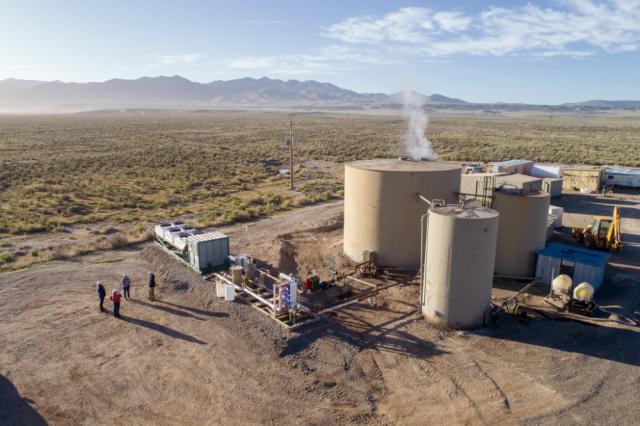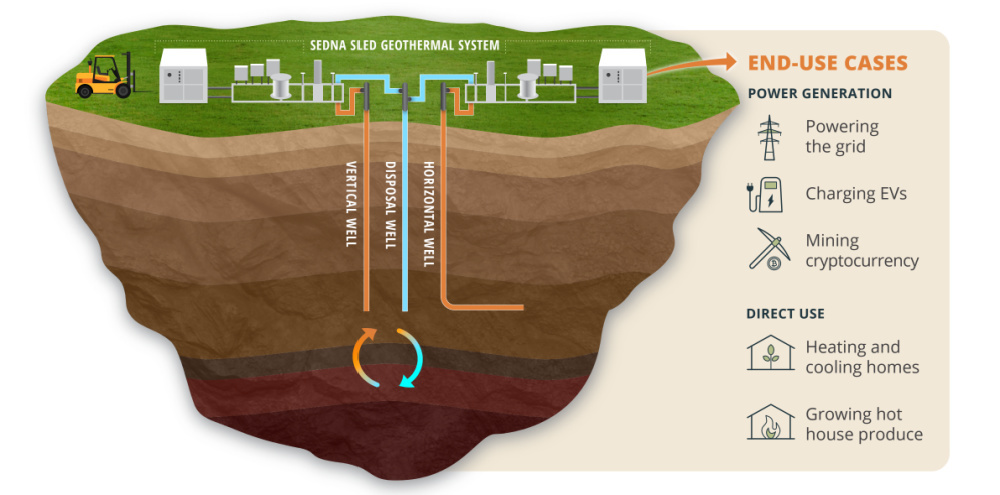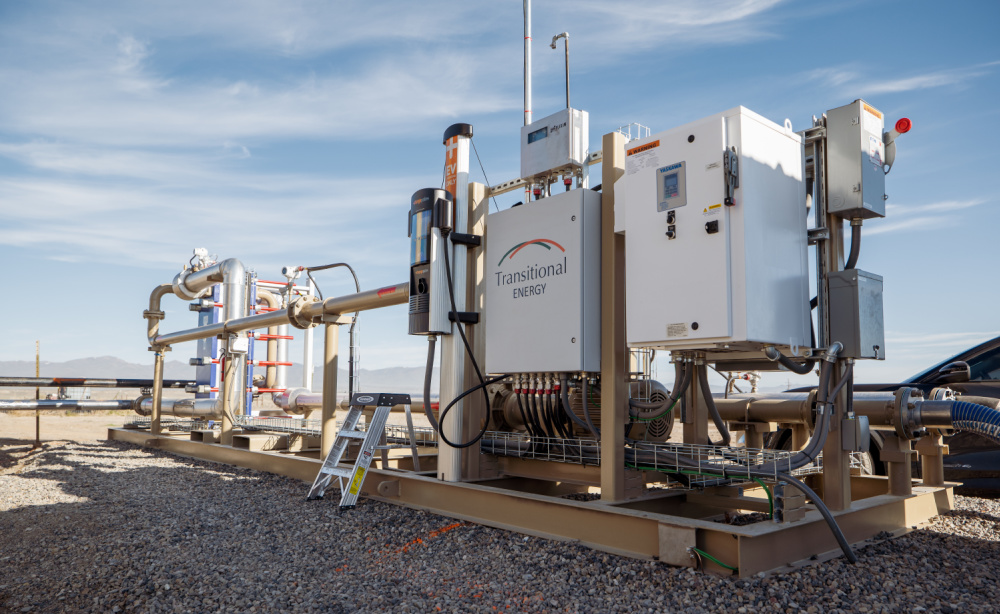
Transitional Energy successfully produces geothermal energy at oil and gas well. (Source: Business Wire)
Transitional Energy sees value in heat waste, having recently harnessed heat from an oil and gas well’s hot fluids to generate power at the Blackburn oil field in Nevada during a pilot project.
The Colorado-based company is now looking to take its oil and gas expertise and low-temperature geothermal energy technology to the next level as part of a U.S. Department of Energy (DOE) project to generate 1 megawatt of power at the oil field.
Geothermal energy can help the industry transition from generating baseload power from coal and natural gas to a renewable energy source that is not intermittent, Transitional Energy CEO Salina Derichsweiler told Hart Energy, pointing out geothermal energy’s reliability and abundance.
“Step No. 1 is thinking about your temperature as a resource. Oil and gas companies tend to think of this as a waste product. ... Switch that mindset from it being a nuisance and waste to it being potential profit and a potential solution.”—Salina Derichsweiler, Co-founder and CEO, Transitional Energy LLC
“The resource is there. We should utilize it,” Derichsweiler said. “Traditionally, geothermal has only been in areas where there’s very, very high temperatures. Now, we’ve had technology advancements so that we can access it from a lot of different places. There are over a million wellbores in the U.S. that have the right temperature. We should use those wellbores.”
Transitional’s geothermal system is comprised of its Sedna Sled technology and an Organic Rankine Cycle (ORC) machine that produces electrical energy from a low-temperature heat source. As explained by the company, hot fluids produced from an oil and gas well pass through the Sedna Sled System and circulate back into oil and gas infrastructure. Heat from the produced fluids is mined through the system before it moves into the ORC, which uses the hot water to vaporize a refrigerant to spin a turbine and ultimately, generate electricity, the company explained.
Results of the pilot project—with operator Grant Canyon Oil and Gas, ElectraTherm and others—announced in May proved that geothermal energy can be produced at oil and gas sites, Derichsweiler said.
She believes that educating people on the benefits of geothermal energy can help increase its development and use in the U.S. as companies work to shrink their carbon footprints.
“Step No. 1 is thinking about your temperature as a resource. Oil and gas companies tend to think of this as a waste product,” she said. “Water is a waste. It’s a nuisance. Hot water is even worse. It melts everything out here. Switch that mindset from it being a nuisance and waste to it being potential profit and a potential solution.”
Derichsweiler recently spoke to Hart Energy about the pilot project and the upcoming project selected by the DOE to install geothermal heat engines at Blackburn for electrical power production. The project, according to the DOE, will result in not only geothermal energy at the site but also construction of rural electric vehicle charging infrastructure.
Hart Energy: How is the operator using the electricity generated on site?
Salina Derichsweiler: Each operator will have a different challenge they want solved. This particular operator was looking for a couple of different things. They want to replace their diesel generation on site with cleaner, cheaper power, and that can be done with geothermal co-production. … There’s only so much power that’s built out in those [rural co-op] systems. This is a way to add power into the system without any additional major capital expenses by local co-ops, so you’re not raising the rates on local people. You’re actually taking some of that power off the grid and generating it right on-site for the oil and gas providers.

HE: What challenges did you encounter and how did you work through those challenges?
SD: This has just been such a fun project. The very first goal we had was to generate electrons, and we’ve successfully done that. … The challenges sometimes are really basic like cell phones. We put a lot of data measurement devices in the system so that we know the temperature, where the flow is, where we’re losing things, how to optimize all those bits and pieces. … We have to measure all of that and then we have to get the data into our computers for us to analyze. Well, if you don’t have any cell phones or any communications out there, it’s impossible to do. We need data every second so we could generate power, but we couldn’t see anything. We were blind to our own data. So, we had to put radio towers out there. It was a 3G network, but everybody had 5G. When is the 3G network going away? How do we plan for six months from now? That’s where a lot of our challenges stemmed from.
HE: How much did the overall project cost? Is it all private funding?
SD: At this time, we’re not disclosing that. We’re a private company. Our target is $2,500 per kilowatt installed and we have line of sight for that target. There’s just so many little things that go into that, and it varies based on where you’re installing. Being the first one out of the gate means lots of design and figuring things out. But $2,500 a kilowatt we still think is a fantastic target. We anticipate actually beating that target. It is all private funding. I think we’re the first company to do that as well. There have been other companies that have done this on grant dollars to see whether it can work. But the technology has advanced enough that we really believed in the idea to go raise those funds ourselves and do this pilot. It needs to happen. We can provide an immediate solution for carbon reduction., and oil and gas companies need an immediate solution. This is a way to have a pragmatic transition to a new clean energy economy.

HE: What’s the next step for the project?
SD: The next step will be spending the summer optimizing the system so that we can feed information into our feasibility study for the 1-MW power generation that’s part of the $2.5 million DOE grant. The information we learn here will go into that project, and we’ll also be getting some geothermal leases in place and doing all the design and engineering for 1 MW out there. Then, we’ll see how big can we go? What are the possibilities? With the Hoover Dam drying up in Nevada, Vegas is going to need some power. California’s looking for geothermal, and this is a really great place for that. Our clients span the western half of the U.S. We’re working with clients in North Dakota, Wyoming, Texas and New Mexico. We’re in Colorado, so a lot of our clients are here in Colorado. All of the information we learn here will feed directly into all of those. We’re planning to lead the way.
[Editor’s note: The interview was edited for clarity and length.]
Recommended Reading
TPG Adds Lebovitz as Head of Infrastructure for Climate Investing Platform
2024-02-07 - TPG Rise Climate was launched in 2021 to make investments across asset classes in climate solutions globally.
Air Products Sees $15B Hydrogen, Energy Transition Project Backlog
2024-02-07 - Pennsylvania-headquartered Air Products has eight hydrogen projects underway and is targeting an IRR of more than 10%.
NGL Growth Leads Enterprise Product Partners to Strong Fourth Quarter
2024-02-02 - Enterprise Product Partners executives are still waiting to receive final federal approval to go ahead with the company’s Sea Port Terminal Project.
Sherrill to Lead HEP’s Low Carbon Solutions Division
2024-02-06 - Richard Sherill will serve as president of Howard Energy Partners’ low carbon solutions division, while also serving on Talos Energy’s board.
Magnolia Appoints David Khani to Board
2024-02-08 - David Khani’s appointment to Magnolia Oil & Gas’ board as an independent director brings the board’s size to eight members.






